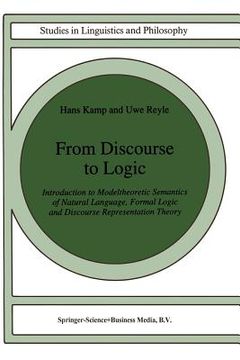Share
From Discourse to Logic: Introduction to Modeltheoretic Semantics of Natural Language, Formal Logic and Discourse Representation Theory Part 1 (in English)
U. Reyle
(Author)
·
Hans Kamp
(Author)
·
Springer
· Paperback
From Discourse to Logic: Introduction to Modeltheoretic Semantics of Natural Language, Formal Logic and Discourse Representation Theory Part 1 (in English) - Kamp, Hans ; Reyle, U.
$ 359.99
$ 379.99
You save: $ 20.00
Choose the list to add your product or create one New List
✓ Product added successfully to the Wishlist.
Go to My WishlistsIt will be shipped from our warehouse between
Wednesday, July 17 and
Thursday, July 18.
You will receive it anywhere in United States between 1 and 3 business days after shipment.
Synopsis "From Discourse to Logic: Introduction to Modeltheoretic Semantics of Natural Language, Formal Logic and Discourse Representation Theory Part 1 (in English)"
Preface This book is about semantics and logic. More specifically, it is about the semantics and logic of natural language; and, even more specifically than that, it is about a particular way of dealing with those subjects, known as Discourse Representation Theory, or DRT. DRT is an approach towards natural language semantics which, some thirteen years ago, arose out of attempts to deal with two distinct problems. The first of those was the semantic puzzle that had been brought to contempo- rary attention by Geach's notorious "donkey sentences" - sentences like If Pedro owns some donkey, he beats it, in which the anaphoric connection we perceive between the indefinite noun phrase some donkey and the pronoun it may seem to conflict with the existential meaning of the word some. The second problem had to do with tense and aspect. Some languages, for instance French and the other Romance languages, have two morphologically distinct past tenses, a simple past (the French Passe Simple) and a continuous past (the French Imparfait). To articulate precisely what the difference between these tenses is has turned out to be surprisingly difficult.

